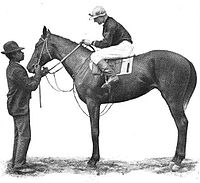Broomstick (horse)
This article includes a list of references, related reading, or external links, but its sources remain unclear because it lacks inline citations. (January 2011) |
| Broomstick | |
|---|---|
 Broomstick with jockey George M. Odom up. | |
| Sire | Ben Brush |
| Grandsire | Bramble |
| Dam | Elf |
| Damsire | Galliard |
| Sex | Stallion |
| Foaled | 1901 |
| Country | United States |
| Colour | Bay |
| Breeder | Col. Milton Young (McGrathiana Stud) |
| Owner | Samuel S. Brown Harry Payne Whitney |
| Trainer | Peter Wimmer Robert Tucker (at age 3) |
| Record | 39 Starts: 14-11-5 |
| Earnings | $74,730 |
| Major wins | |
| Great American Stakes (1903) Juvenile Stakes (1903) Expectation Stakes (1903) Travers Stakes (1904) Brighton Handicap (1904) Flying Handicap (1904) | |
| Awards | |
| Leading sire in North America (1913, 1914, 1915) Leading broodmare sire in North America (1932, 1933) | |
| Honours | |
| U.S. Racing Hall of Fame (1956) | |
Broomstick (1901–1931) was a Thoroughbred race horse born and bred at the famous McGrathiana Stud in Kentucky, but more importantly, he was one of the great sires of American racing. Out of another great sire, the Hall of Famer Ben Brush, Broomstick went on after his racing career to produce champion after champion for many years.
The important horseman, James R. Keene (who owned Domino, Kingston, Colin and Sysonby among so many other memorable horses), also owned Elf, Broomstick's dam. Believing she was barren, he sold her to Milton Young. One year later she foaled Broomstick. As a yearling Broomstick then went to a Pittsburgh, Pennsylvania coal millionaire named Captain Samuel S. Brown who was a member of The Jockey Club and the owner of two racetracks.
Broomstick was small, but he won his first three stakes at two. Because of this, he was weighted down rather heavily for such a young horse and consequently won fewer races at that age. He placed in the Saratoga Special, the Walden Stakes, the Flatbush Stakes, the Great Trial Stakes and the Spring Stakes.
At three, and under another trainer, he won the Travers Stakes. In the Brighton Handicap he beat older horses and set a record that stood for nine years. In that race he was up against the truly game Irish Lad who broke down nearing the wire, but finished on three legs, only barely beaten.
Still heavily weighted, he placed in the Merchants and Citizens Handicap, the Hindoo Handicap, and his second Saratoga Special.
At four his only important effort was a place in the Century Handicap.
At stud
Broomstick was retired to stud duty at Capt. Brown's Senorita Stock Farm near Lexington, Kentucky where he sired three crops including 1911 Kentucky Derby winner Meridian, Sweeper II who raced in England and in 1912 won the Classic 2,000 Guineas Stakes, and the 1913 American Horse of the Year Whisk Broom II who went on to sire Whiskery, the winner of the 1927 Kentucky Derby. Capt. Brown died in late 1905 and his brother, W. Harry Brown, continued on with the business until November 23, 1908 when he sold Broomstick and twenty-eight other horses at a Fasig-Tipton auction. [1]
Purchased by Harry Payne Whitney, Broomstick was sent to stand at his Brookdale Farm in New Jersey where he continued as a great sire. Even with only an average eleven foals per crop, of those eleven foals twenty five percent were stakes winners. The best of the lot was Regret, the first filly to win the Kentucky Derby which she did in 1915. He also sired Cudgel who, in his time, beat Exterminator, Sun Briar, Johren, and Roamer. And then there was the extraordinary Tippity Witchet who raced 266 times over thirteen seasons and won 78 of those starts, came in second 52 times, and third 42 times.
Broomstick was America's leading sire from 1913 to 1915 and among the top ten for 17 years: 1910 to 1927. He died when he was thirty years old, only a few years past being at his best.
External links
- Broomstick’s pedigree
- Broomstick in the Hall of Fame
- The Spell of the Turf by Sam Hildreth and James R. Crowell
